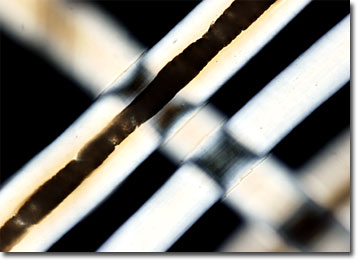Polarized Light Microscopy Digital Image Gallery
Cow Hair
Believed to have been domesticated since the New Stone Age, an extensive vocabulary has been developed to refer to cattle of various types. A female, for instance, begins as a heifer calf, and then grows into a heifer, and when reaching maturity is referred to as a cow.

View a second image of Cow Hair
In some parts of the world, such as Africa and Asia, domestic cattle appear very similar to the animals that inhabited those areas thousands of years ago. However, in Europe and the Americas, a number of relatively new breeds have been developed through controlled breeding efforts. Most of the breeds have derived from the species Bos taurus and Bos indicus, but vary significantly from the original strains since they have been altered to improve strength, milk production, or quality of meat, depending on the intended use of the animal. Indeed, selective breeding efforts began even before the field of genetics was developed. Typically credited with commencing these efforts is Robert Bakewell, an English farmer who introduced philosophies such as “like begets like” and “breed the best to the best” in the eighteenth century.
Cows and other cattle are subject to a number of diseases, but most recent concern has been focused upon bovine spongiform encephalopathy, also known as mad cow disease. First recognized in 1986, the disease, which is similar to a neurodegenerative disorder that sometimes occurs in sheep, is generally believed to have developed when cattle were fed animal-derived protein supplements. Apprehension that that the condition could be transmitted to humans led to a heightened interest in closely monitoring the diet of cows, and this interest has led to an important breakthrough. Recently, a German scientist utilized the established technique of isotopic analysis to examine the hair of cows, enabling him to reconstruct the animals’ entire environmental and dietary history.
